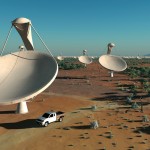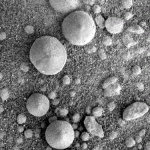
The barren polar desert landscape of Devon Island in northern Canada is quite similar to Mars. A small trial base has been established there. Image: Archive
Setting up a permanent base on Mars may no longer be a dream. The plans are already there, we only need funding. Will we reach Mars by 2030?
In 1951, the famous author Arthur C. Clarke wrote the science fiction novel The Sands of Mars. It was one of the first attempts to speculate on the future colonisation of our neighbouring planet, and there is little doubt that the text inspired many of the scientists who have subsequently devoted their life to researching the Red Planet.
Clarke’s novel is set on Mars in a universe where it has been colonised by humans and used as a research facility. People walked the streets of Mars — the temperature was so high and the air so dense that it was only possible to go outside wearing Mars-appropriate clothing and an oxygen mask — and therefore the idea of colonising the Red Planet became appealing.
But real Mars explorers won’t have such an experience. Even though research indicates that the planet is much less similar to Earth than we once thought, that has not curbed interest in building bases and colonies. Recent research has revealed both good and bad news for those who might wish to establish themselves in Mars. There appears to be large quantities of ice right beneath the surface, and easy access to water would certainly help in the colonisation process. Unfortunately, the Red Planet’s atmosphere is very thin, with a pressure similar to that found 29 kilometres above the Earth; and there is no ozone layer protecting against ultraviolet radiation from the Sun, which means that it would be necessary to wear a space suit outside the residential modules.
Another issue hindering Mars exploration is the difficulty of landing. The thin, erratic atmosphere is able to slow down probes weighing up to a couple of tonnes, and those can descend by parachute. But this would be impossible with a 30-to-60-tonne spacecraft, which is the expected weight of payloads carrying all the necessary survival supplies for a manned mission on the planet. The last phase of the landing would have to be facilitated by braking rockets, which would require fuel to be carried thousands of kilometres from Earth. This presents such a problem that it is forcing scientists to consider the possibility of producing fuel on Mars for the return trip.
Establishing a base
Most manned missions plan for 500 days spent on the planet, but it is possible that astronauts would begin establishing a permanent base in connection with the first landing. Because of the enormous distance and long travel time, it would be necessary to consider staying on Mars for many months, perhaps even for several years.
The first base will most likely be modest, and will encounter obstacles large and small, from dust invading everything to cosmic radiation. Most probably, the base will be built on Earth and sent to Mars onboard an unmanned spacecraft, which would limit its size. A good estimate is a cylinder with an eight-metre diameter and a height of 10 metres, as envisioned by the Mars Society, which is led by engineer Robert Zubrin. For years, the members of the organisation have tried to prepare for man’s trip to Mars — they have even built models of the bases in Arctic Canada.
Third Time is the Charm
The society is now designing its third and most sophisticated model, the three-story European Mars Analogue Research Station Project (Euro-MARS), meant to house six astronauts for almost two years. On the ground floor there will be laboratories, where researchers will be able to analyse samples. Those results will be of the utmost importance as it will not be possible to bring much back to Earth. Scientists will rely heavily on an electron microscope, which can magnify microorganisms, and an X-ray spectrometer, which can be used to determine the mineral makeup. A gas chromatograph will be utilised to examine the samples’ organic substance content.
From the ground floor, the astronauts will be able to access the surface by passing through two air locks; between the two locks will be a repair shop. On the first floor there will be a living room, kitchen, bathroom, storm cellar and gym. Exercise will be crucial, because the gravity of Mars is roughly one-third of the Earth’s. And in order to keep their bones and muscles healthy, the astronauts will need to exercise for one to two hours a day — according to NASA muscle mass can vanish at a rate of up to five per cent a week in zero gravity conditions. The storm cellar will be necessary in case of solar eruptions, which entail dangerously high radiation levels and occur because Mars has a very thin atmosphere and no magnetic field whatsoever.
Though the base will be designed to be as comfortable as possible, its inhabitants will spend quite a lot of time outside the base doing research. A large part of their job will consist of driving around in large vehicles complete with pressure cabins and air locks, allowing them to leave the vehicle and do fieldwork. Some the expeditions may last several weeks and take them up to 498 kilometres away from the base.
Plants and Fuel
The two main tasks of the first base will be the production of food and fuel. Plants will be grown in greenhouses, which presents the unique challenge of maintaining a terrestrial environment and climate on Mars. One idea has been to create genetically modified plants, which could be altered to cope with ultraviolet radiation and low temperatures, and survive on very little water.
The second vital task for the astronauts will be the production of fuel. They will use the Sabatier process, which involves a simple reaction between hydrogen imported from Earth and CO2 from Mars’ atmosphere. In the process, hydrogen and CO2 are converted into methane and water. The water produced can then be separated into oxygen and hydrogen by electrolysis; the hydrogen can be reused in the process, while the oxygen can be utilised to burn methane in the rocket engine. The operation will require a lot of energy, so a small nuclear power station will have to be built rather close to the base, likely being carried to the planet aboard one of the early spacecrafts.
The Dream of Colonisation.
In the short, man’s presence on Mars will most likely resemble the Amundsen-Scott South Pole Station, where a small team of scientists live under extreme climatic conditions. But the dream of colonising Mars remains strong, and as space operations gradually become less expensive, the emergence of a real colony is not impossible. It would mean establishing something similar to the domed cities described by Clarke in his 1951 novel, and it would present an entirely new set of challenges.
A modest greenhouse and small plants would no longer be enough; a closed biosphere similar to Biosphere 2 would be necessary, including both plants and animals, so as not to have to import food from Earth. Another issue would be the transportation costs of building materials, though it’s possible to make bricks on Mars. In the 1980s, scientists realised that it would actually be quite easy to manufacture them. According to engineer Bruce MacKenzie of the Mars Homestead Project, the best material for building the first city on Mars is brick, which can be made by simply taking some surface dust, adding water, and then squeezing, drying and baking it. It is also possible to produce mortar and cement, so the first buildings on Mars could very well be neat redbrick houses. Other possible construction materials include fibreglass, which can be produced in Mars, some metals and polymers.
The low temperatures and the radiation from space also present challenges. One solution could be to build the houses in ditches and subsequently cover them with cement. Engineers could also construct a dome over the entire settlement, which could be built in the shape of a square. Under the dome, there could be green plants and perhaps an artificial lake.
Living beneath such a dome would, however, come at a price. The gravity on Mars is only 38 per cent as strong as the gravity on the Earth, and children born and raised on the Red Planet might not be able to travel to Earth because their muscles and bones wouldn’t be able to cope with Earth’s gravity. Even settlers who had gone to Mars (considered by some researchers as the most hospitable place in the solar system beyond Earth) as adults would probably face great difficulties if they wanted to visit Earth again
Terraforming Mars
In the foreseeable future, a Mars colony could at most support a few thousand people, but if it were possible to terraform the planet, it could, in theory, support a much larger population. Terraforming — changing the temperature and atmosphere of a planet enough to enable humans to live unconstrained on its surface — is possible in theory.
Some scientists believe that Mars was once very similar to Earth. According to geologists, there may have been a large ocean in the Northern Hemisphere some three billion years ago, just as there were rivers and active volcanoes. At that time, Mars was both warmer and more humid. But re-creating this scenario would be a project that would demand patience over the course of many generations. Even in the most favourable conditions, it would take several thousand years to convert the Red Planet to a blue and green globe resembling Earth.
Nevertheless, scientists have already begun to consider how to undertake such a spectacular project. The first person to present the idea was Carl Sagan, who suggested terraforming Venus in 1961. In the following years, Sagan came to play a central role in the exploration of the Solar System, and in 1973 he described how it would be possible to terraform Mars.
Since then, the idea has been taken up by several other scientists, the most well known of whom is environmentalist and futurologist James Lovelock, who first proposed the Gaia hypothesis, which conjectures the Earth as a self-regulating superorganism. In 1984, he and Michael Allaby wrote The Greening of Mars, in which they first described the possibility of using chlorofluorocarbon (CFC) gases to create an extensive global warming effect. Raising the planet’s temperature would be the first step in successfully terraforming it (ice would melt and rivers would form).
There are three possibilities — first, as Lovelock suggested, by enriching the atmosphere with powerful CFC gases that are much more efficient at warming than the CO2 that is already present. The second possibility would be to increase solar radiation by placing giant mirrors in orbit around the planet. Finally, fine dust, perhaps from the two small moons Phobos (whose name means “˜fear’ in Greek) and Deimos (terror), could be spread over the polar caps, allowing Mars to absorb sunlight more efficiently.
Adding Melted Ice to the Atmosphere
If the polar caps melt, then the billions of tonnes of ice and snow found there could contribute to the atmospheric density and therefore to global warming. But if scientists hope to generate a denser atmosphere, it may also be necessary to include the ice found below the surface, which melts once it is brought into contact with the air. Bringing the ice into the open would require using powerful explosives or perhaps bombarding Mars with giant rocks and meteors, which could crack the surface open.
But even after hundreds of years, the atmosphere would still be cold, thin and almost devoid of oxygen. Consequently, biologists will need to take over and introduce robust fauna. At first it could be customised moss and lichen, followed by pine trees. The plants would generate fertile topsoil and convert atmospheric CO2 into oxygen. Later, scientists hypothesise, genetically modified animals that could survive in such a climate will be introduced. The last step in colonisation would be to leave the domed cities and occupy the entire planet. Only with the investment of significant time, energy and financial resources might scientists transform Mars.
Don’t forget to get a copy of our Mars issue, just click here






